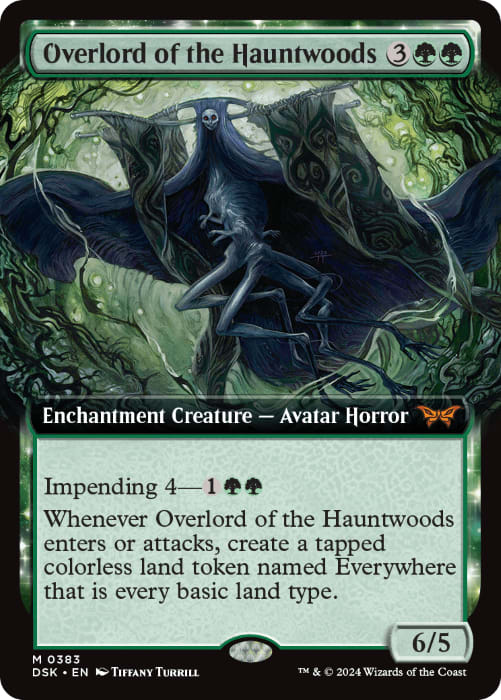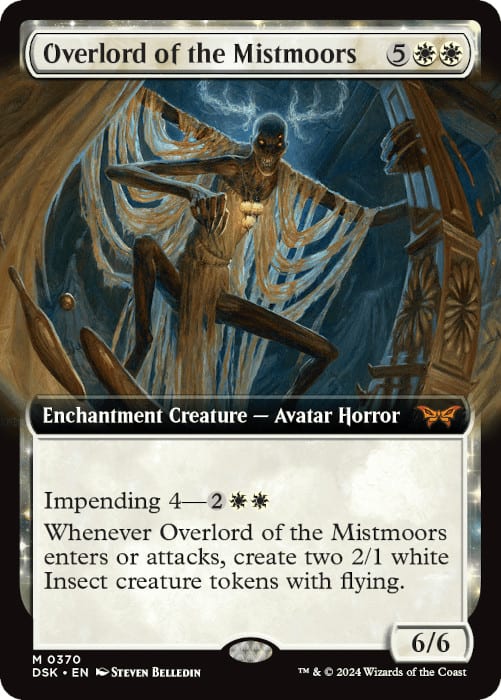Duskmourn releases today, September 27th and one of the set's main mechanics has a very familiar feel...
While you might think we're talking about the Rooms that feel like split cards, this time we're talking about the "impending" mechanic! Impending is only found on five specific cards in Duskmourn, and has a few connections to other cards and mechanics in the game, most notably mechanics that include time counters, like fading and suspend.
Just like suspend, impending has its own cost, such as 1B, and its own numerical value, such as "5." It works as follows:
If you cast this spell for its impending cost, it enters with N time counters and isn't a creature until the last is removed. At the beginning of your end step, remove a time counter from it.
My immediate first reaction was that this was just a modification of suspend, where the card resides in play instead of in exile as the time counters tick down. But the biggest notable difference is that the time counter is removed at the beginning of your end step, rather than your upkeep. The best reason I can think of for this is so that the creature can't attack the turn it enters the battlefield when the last time counter is removed. If it was removed during the upkeep, the creature would be able to attack since the card has been in play the entire time. Considering that all of the Overlords have pretty strong abilities that trigger when they attack, it seemed logical that they would want those delayed.
Interestingly enough, however, even though suspend cards entered the battlefield from exile when the last time counter was removed, the suspend ability specifically grants the creature haste. So clearly R&D didn't have an issue with suspend creatures coming into play and just heading straight into the red zone. I'm not sure why things are different with impending.
The only five cards with impending are the five Overlords.
Overlord of the Balemurk
This has the longest impending time at five turns. Assuming you cast this on turn two, when you have two mana, the last counter will come off on turn six and you'll be attacking with it on turn seven. This means by impending it, you'll be attacking with this a turn later than if you had just cast it on turn five.
This is the downside of paying a significantly discounted rate for a 5/5 creature with an attached card draw ability.
Overlord of the Boilerbilges
Only four impending here, so four time counters. Assuming you impend(?) on turn four, one counter comes off on turn four, five, six, and seven, and you'll be attacking on turn eight. Compare that to casting this on turn six and attacking on turn seven.
Overlord of the Floodpits
Impending works the same here with the impending cost being two mana less than the mana cost. Impend on three, with a counter coming off on three, four, five, and six. Attack on seven, as opposed to casting on five and attacking on six.
Overlord of the Hauntwoods
Overlord of the Hauntwoods works the same as Overlord of the Floodpits.
Overlord of the Mistmoors
Impending Overlord of the Mistmoors might be the best value. If you impend on turn four, a counter comes off on turns four, five, six, and seven. Which leaves you attacking on turn eight, whether you impend or hardcast.
For 80% of the Overlords, impending amounts to spending an average of 63% of the mana much earlier in the game, to attack one turn later. For the remaining 20% of Overlords - Overlord of the Mistmoors - casting it or impending it will result in attacking on the same turn, so you might as well just save the three mana.
Of course, this all assumes that you'll have drawn the Overlords earlier in the game and use their impending ability on the perfect turn. If you simply draw them on turns five, six, or seven, then you should typically just cast them.
What about if you draw them in the between turns, like drawing an Overlord of the Balemurk on turn three or four?
Personally, I think I would still impend on turn three, to free up my mana on turn five. Meanwhile, I would just hold it for a turn if I drew it on turn four. But, of course, your mileage may vary and these suggestions are entirely situational.
Impending seems very interesting. While it's only available on five marque cards, the cards are all interesting enough to play, with some being absolutely fantastic, so the mechanic should still see a good amount of play.
Frank Lepore




























